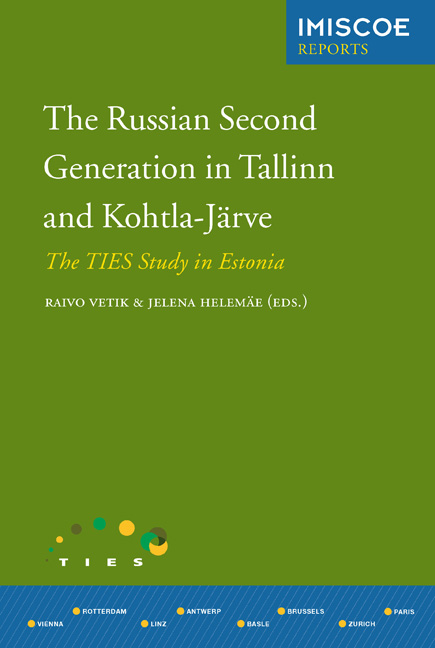Book contents
- Fronmatter
- Contents
- Preface
- List of Tables, Figures and Chapter Appendices
- 1 Introduction
- 2 Migration Patterns
- 3 Integration Policies
- 4 Ethnic Inequalities in Education
- 5 Explaining Different Returns from Human Capital in the labour Market
- 6 Income Inequality
- 7 Housing Conditions Andneighbourhood Satisfaction
- 8 Contact and Crisis in Interethnic Relations
- 9 Gender role Attitudes
- 10 Sense of Belonging to Estonia
- 11 Conclusions
- Appendix
- List of Contributors
- Other IMISCOE Titles
6 - Income Inequality
Published online by Cambridge University Press: 20 January 2021
- Fronmatter
- Contents
- Preface
- List of Tables, Figures and Chapter Appendices
- 1 Introduction
- 2 Migration Patterns
- 3 Integration Policies
- 4 Ethnic Inequalities in Education
- 5 Explaining Different Returns from Human Capital in the labour Market
- 6 Income Inequality
- 7 Housing Conditions Andneighbourhood Satisfaction
- 8 Contact and Crisis in Interethnic Relations
- 9 Gender role Attitudes
- 10 Sense of Belonging to Estonia
- 11 Conclusions
- Appendix
- List of Contributors
- Other IMISCOE Titles
Summary
Introduction
Income refers to a consumption opportunity gained by an entity within a specified time frame, which is generally expressed in monetary terms (Barr 2004). However, for households and individuals ‘income is the sum of all the wages, salaries, profits, interests payments, rents and other forms of earnings received in a given period of time’ (Case & Fair 2000).
In this chapter we focus not so much on consumption opportunity but rather, on the importance and amount of income from employment, as well as on the probability of belonging to a highly paid group of employees. Income inequality is of particular importance for at least two reasons: 1) it is the indication of labour market success or failure; 2) it is an important economic resource that (to a great extent) determines the living conditions of the individual and/or his household. The first approach focuses on the factors of individual labour market behaviour. The second approach takes into account the income generating capabilities of the household as a whole, given the assumption that these capabilities determine the resources and welfare available to the individual. In this chapter, we focus on the first approach.
Ethnic inequality in income is a frequently documented phenomenon in many developed countries (see e.g. Borjas 1985, 1995; Chiswick & Miller 1995; Husted, Nielsen, Rosholm & Smith 2001; Nielsen, Rosholm, Smith & Husted 2004; Black, Haviland, Sanders & Taylor 2006; Inglis & Model 2007; Tesser & Dronkers 2007; Hammarstedt 2009). Some researchers have found that immigrants in Western Europe earn around 40 per cent less at arrival than natives born in that destination (Adsera & Chiswick 2007). According to others, the difference is smaller (and depends, in turn, on gender; Antecol, Cobb-Clark & Trejo 2003; Treiman 2007) and usually diminishes with time since migration (Chiswick 1978; Baker & Benjamin 1994; Schoeni 1997; Friedberg 2000).
Different factors are used to explain the disadvantage of immigrants. Some explanations stress the role of a lower level of human capital, meaning educational attainment (Becker 1964; Mincer 1974); others focus on country-specific human capital, meaning, primarily, the language proficiency of the immigrant population (Chiswick 1978). A third group of explanations relate to structural factors and ethnic segmentation across industries (Kalleberg & Berg 1987; Le Grand, Szulkin & Thalin 1994).
- Type
- Chapter
- Information
- The Russian Second Generation in Tallinn and Kohtla-JärveThe TIES Study in Estonia, pp. 119 - 142Publisher: Amsterdam University PressPrint publication year: 2012



